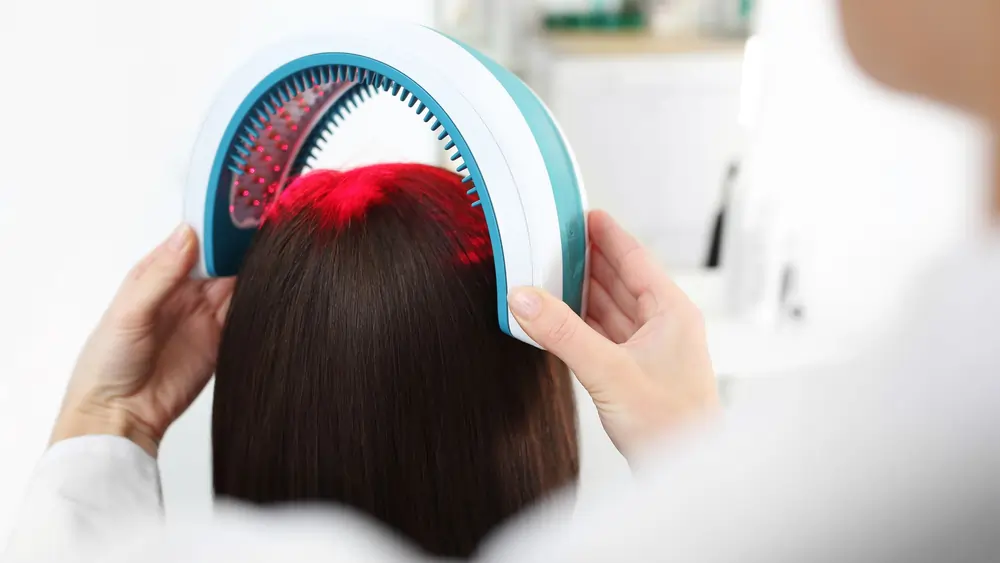Temporary hair loss known as telogen effluvium typically follows stress, shock, or a traumatic experience that generally affects the top of the scalp. Carry on reading to learn more about this type of hair loss, the causes, symptoms, treatments and more.

A Better Understanding About What Telogen Effluvium Is
A person is said to have chronic telogen effluvium if they routinely go through hair-loss episodes that last for more than 6 months. In most cases, telogen effluvium can be reversed.
While the hair may significantly thin out, a person with this illness does not completely lose all of it.
Hair thinning or an increase in hair shedding are two characteristics of the hair loss condition telogen effluvium. A disruption in the hair cycle is typically what causes telogen effluvium, and it is seen more frequently in women than in men.
Our hair goes through three different phases. These phases are known as:
- Anagen: The growth stage
- Catagen: The transitional stage
- Telogen: The resting stage
The telogen phase is correlated to telogen effluvium. At any given time, 5 – 10% of a person’s hair is typically in the telogen phase. Telogen effluvium causes the anagen phase to slow down, which results in fewer hairs entering the following two phases. About 30% of the hair follicles affected by this disorder enter the telogen phase, which results in hair shedding.
The Causes of Telogen Effluvium
People of all ages and both sexes may experience acute telogen effluvium. The majority of otherwise healthy women between the ages of 30 and 60 are likely to develop chronic telogen effluvium without a clear triggering event.
When it comes the causes of telogen effluvium, there are many different triggering points. Some of these include:
- Stress: Telogen effluvium can be brought on by extended periods of stress. Usually, hair loss starts 3 months after a stressful event.
- Unhealthy or Poor Diet: Protein, iron, B vitamins, and zinc are necessary aspects for hair growth. A lack of these nutrients may have an impact on a person’s hair’s quantity and quality.
- Weight-Loss: Hair loss may result in weight reduction or long-term calorie restriction, as seen in anorexia nervosa.
- Metal Toxicity: Hair loss can result from contact with the harmful compounds found in metal.
- Underlying Medical Issues: Alopecia areata, thyroid disorders, and autoimmune diseases are a few examples of autoimmune diseases that can contribute to telogen effluvium.
- Child Birth: Hair loss can be brought on by hormonal changes that take place 3 to 6 months after birth. Post-partum telogen effluvium is the term used for this.
Signs & Symptoms of Telogen Effluvium
With no clinical signs of inflammation, telogen effluvium is a non-scarring kind of widespread hair loss that can affect up to 50% of the scalp’s hair. An increase in hair loss is the primary symptom of telogen effluvium. When washing or brushing your hair, you could find that there are more hairs falling out than usual. Additionally, you might discover extra hair on your pillow or in the drain.
Seeing as the same factors affect both nail and hair growth, an interruption of your hair growth is frequently reflected in your nails by a groove that runs across them at the same time as the shock to your system. This is known as a beau line. A fingernail takes 5 months to grow from the posterior nail fold to the free edge, so this knowledge can be used to estimate how long the shock will last.
How to Diagnose Telogen Effluvium
Telogen effluvium can be identified using a number of tests. A doctor may be able to identify this ailment and distinguish it from alopecia based on the width and length of the lost hairs. Your doctor may perform the following tests:
- Hair Pull Test: To determine how much hair is shed, a hair pull test may be used.
- Wash Test: The number of hairs shed while washing can be counted during a wash test.
- Blood Test: In order to determine the cause of hair loss, a blood test may be helpful. These tests can be used to identify thyroid or iron deficiency disorders.
- Trichogram: A trichogram can assist in confirming the diagnosis; telogen effluvium is strongly suggested if there are more than 25% of telogen hairs in the trichogram.
- Light Microscope: A light microscopic analysis reveals club hair.
- Scalp Biopsy: Rarely is a scalp biopsy required; it should reveal a normal terminal/vellus hair ratio, an increased number of telogen follicles, and minimal to no fibrosis and inflammation.
Telogen effluvium might be identified and treated by a dermatologist. Other signs of healthy hair, like how the scalp looks, any bald spots, or more widespread hair thinning, will also be examined.
Oftentimes, a thorough medical history and physical exam are enough to determine whether or not you’re suffering from telogen effluvium. A biopsy can confirm an increase in the proportion of telogen hairs if it is performed during the acute shedding phase (when the pull test is positive). Testing for these disorders is advised if there is suspicion of an iron shortage, a chronic metabolic disease, or a hormonal imbalance (such as hypothyroidism).
Telogen Effluvium Treatments
The cause of the hair loss will determine the best course of treatment for telogen effluvium. The hair cycle should return to normal and hair will start to grow again once the trigger has been identified and treated.
Some of the options for treatment include:
- Correcting nutritional deficiencies through your diet by including lots of protein, fruit, and veggies.
- Hormone replacement therapy for women going through menopause
- Treat any identified hormonal issue or underlying scalp disorder, if any.
- Counselling support to manage stress or anxiety
- Avoid overly forceful combing, brushing, and any kind of scalp massage by touching the hair delicately.
- Restore normal thyroid function and iron, vitamin B12, and folic acid levels.
It is advised they you make an effort to avoid any heat or chemical treatments that can harm your hair. Additionally, you should refrain from applying heat to their hair by curling or perming it.

Our Overall Thoughts About Telogen Effluvium
The most frequent cause of diffuse non-scarring alopecia is telogen effluvium. It is distinguished by a sudden beginning of generalised hair loss, which typically occurs 2–3 months following a triggering event.
In contrast to chronic telogen effluvium, where it lasts longer than 6 months, it often self-limits after 6 months. There is no specific medication for telogen effluvium. If you can find the triggering factor of your telogen effluvium, then you can easily treat your hair loss.
Other Types of Hair Loss
Read more about the different types of hair loss




